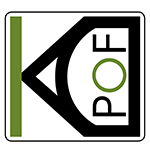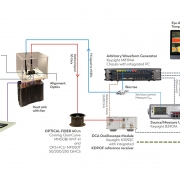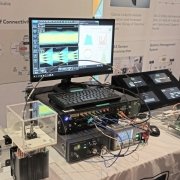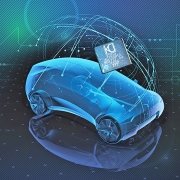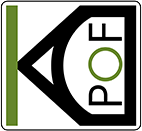Together with several industry leaders, KDPOF is working on an optical automotive multi-gigabit system that will fulfill the needs of future connected and automated vehicles. Instead of various port components, the new solution provides a single, complete package. “As the auto industry approaches the 50 Gb/s*m speed-length threshold, the move from copper to optical physical data transmission media is becoming mandatory,” stated Carlos Pardo, CEO and Co-founder of KDPOF. “Optical is the engineering-wise path for higher data rates.” The new connector systems are very small, lightweight and extremely inexpensive compared to the previous ones. With the comprehensive EVK9351AUT evaluation kit, automotive manufacturers and suppliers can already test the new configuration at 1 Gbit/s today. KDPOF thus supports easy project entry into optical gigabit connectivity for a secure Ethernet backbone and ADAS sensor connections in vehicles. Read more
Posts
KDPOF is looking forward to participating in the upcoming virtual ISCAS 2020 from October 10 to 21 with several contributions: a presentation on multi-gigabit Ethernet for the automotive industry, an overview lecture on high-speed data communications over POF, and an important role in the final industry panel session. The IEEE International Symposium on Circuits and Systems (ISCAS) is the flagship conference of the IEEE Circuits and Systems (CAS) Society and the world’s premiere networking forum for researchers in the highly active fields of theory, design, and implementation of circuits and systems.
Presentation: Towards the Multi-Gigabit Ethernet for the Automotive Industry
On Tuesday, October 13, 2020, from 17:15 to 18:55, session Chairmen Enrique Prefasi Sen, Analog and Mixed Signal Senior Designer of KDPOF, and Alberto Rodríguez-Pérez, Analog and Mixed Signal Manager of KDPOF, will present the paper “Towards the Multi-Gigabit Ethernet for the Automotive Industry”. The paper, within the special session “Multi-gigabit Wireline & Optical Communication Circuits & Systems Session”, will show the status of Ethernet-based communication solutions, focused on optical links for the automotive industry. First, the presenters will display the implementation of a product compatible with the 1000BASE-RHC according to the IEEE Std 802.3bv, which is the first one able to transmit 1 Gbps over POF for automotive. Second, the KDPOF experts will describe a new architecture to achieve up to 25 Gbps for automotive. The proposed multi-gigabit system leverages existing technologies such as VCSELs, multi-mode fibers, and photodiodes already developed for the data center industry.
Lecture: High-Speed Data Communications over Plastic Optical Fibers
Alberto Rodríguez-Pérez will give an overview lecture on Saturday, October 17, 2020, from 16:00 to 16:45 in virtual room 2. In his lecture, Alberto will show an overview of the use of Plastic Optical Fiber as a medium for optical data communications and the techniques needed to get high speed data bitrates over POF. It is an interesting alternative optical communication channel to the Glass Optical Fibers (GOF) for applications that are not required to cover long distances, such as home or automotive networking. However, the reduced low bandwidth of the POF channel imposes big limitations in the maximum data bitrate that can be transmitted through this medium. Consequently, advanced data communication techniques such as channel equalization, data error correction, or data signal modulation need to be applied to achieve data bitrates above 1 Gbps.
Industry Panel
KDPOF is also substantially involved in the final Industrial Panel Discussion on Wednesday, October 21, 2020, from 16:45 to 17:45. Alberto Rodríguez-Pérez will chair the panel and Rubén Pérez de Aranda, CTO of KDPOF, will participate as panelist.
At the virtual Wire Harness Congress on September 22, 2020, KDPOF will display insights and update on Optical Multi-Gigabit Connectivity. In their presentation at 15:50, Juergen Schachtschneider, Automotive Manager Central Europe & Greater China, and César Esteban, Applications & Support Manager, will prove how automotive networks profit from optical technology. Electric and autonomous driving architectures are substantially pushing the challenges for wiring systems. Issues include electromagnetic interference (EMI), electromagnetic susceptibility (EMS), and weight reduction. On top, automotive applications, utilization, and safety requirements are boosting the necessary network speed tremendously. The new 48-volt electrical architecture in cars additionally pushes the envelope in terms of cross-domain isolation requirements. Copper links for communication rates above 100 Mb/s need heavy and expensive solutions to comply with the stringent OEM’s EMC specs, resulting in high cost and very difficult engineering. Moreover, the weight of the ever-growing diameter of the required cables plays against the race for range increase of electrical powertrains.
The presentation will prove how optical network technology overcomes these trends thanks to its inherent galvanic isolation, robustness, low cost, and low weight. Carmakers will benefit from optical links for communications between the 48-volt and the 12-volt domains. For weight, the optical network will save more than 30 percent of the equivalent copper-based harness weight. Optical Ethernet provides 100 Mb/s and 1 Gb/s network solutions today, and multi-gigabit Ethernet is the significant upcoming breakthrough for in-vehicle networks. The standardization effort for optical multi-gigabit is already in progress within the IEEE as an amendment to the Ethernet standard 802.3.
